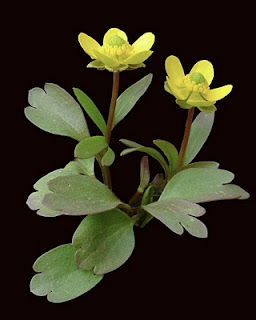Sagebrush Buttercup
Ranunculus glaberrimus
Ranunculaceae (Buttercup Family)
The genus Ranunculus comes from the Latin word for frog (rana) because many species grow in wet places. This species, however, is most often found in sagebrush steppe and on open pine forest floors Glaberrimus means totally glabrous, or without hairs.
Quick ID:
 One of the earliest wildflowers; look for Sagebrush Buttercup blooming now through June in Missoula! Plants are fleshy and 5-20 cm high (smaller than the similar native Mountain Buttercup, Ranunculus eschscholtzii). Leaves are very smooth, round to three-toothed, clustered mostly at the base. The shiny yellow flowers are about the size of a quarter. It's sometimes confused with Silvery Cinquefoil (Potentilla argentea), but they're easily told apart. P. argentea has 5 pointy bracts alternating with its yellow petals and toothy, palmate leaves.
One of the earliest wildflowers; look for Sagebrush Buttercup blooming now through June in Missoula! Plants are fleshy and 5-20 cm high (smaller than the similar native Mountain Buttercup, Ranunculus eschscholtzii). Leaves are very smooth, round to three-toothed, clustered mostly at the base. The shiny yellow flowers are about the size of a quarter. It's sometimes confused with Silvery Cinquefoil (Potentilla argentea), but they're easily told apart. P. argentea has 5 pointy bracts alternating with its yellow petals and toothy, palmate leaves.Range:
From BC to New Mexico and California east to the Dakotas. Found in most parts of Montana (map)
Tidbits:
Ranunculus is toxic to eat (including to horses and livestock), and can cause mild burning or blistering skin if handled. The Okanagan-Colville Indians of the Pacific Northwest used sagebrush buttercups placed on a piece of meat as poisoned bait for coyotes, and rubbed flowers or whole plants on arrow points as a poison. The toxin is unstable, and destroyed by boiling or drying.
Children all over the world play the "Do you like butter?" game, checking if the golden yellow flowers reflect off their pals' chins. The sketch above is from the Royal Academy Notes for 1889. Some things never change.
Children all over the world play the "Do you like butter?" game, checking if the golden yellow flowers reflect off their pals' chins. The sketch above is from the Royal Academy Notes for 1889. Some things never change.
Wild gardening:
A cold-hardy perennial that brings early spring color; Sagebrush Buttercups need a sunny, well-watered spot. Sources for seeds and plants may be hard to find, but worth trying. The bright yellow petals secrete nectar, attracting an array of pollinators. They're also also one of the first true heralds of spring, braving the still-icy winds as a promise of warm days to come.
Links to photos used here:1, 2, 3, 4
Spotlight On... features Montana native plants that are currently on display in our natural areas. Have a plant that you'd like to see featured? Let us know!



Walked partway up the M trail today - and the trail that branches off to the left above the canyon - and saw Fritillaria (nodding yellow bells) in bloom and a yellow biscuit root? (Lomatium?) One Geum was in bud already! Lots of Buttercups along the river trail East of the Waterwise Garden behind the Missoulian.
ReplyDeleteAll three of these flowers are yellow. Is it because they are pollinated by insects?
Can you believe spring is in full swing already?!
ReplyDeleteYou're right, the biscuit root you saw was likely Lomatium cous. Most yellow flowers (esp. these small, early-spring annuals) are pollinated by bees--both European honeybees and our many species of native solitary bees. The bees in our Nature Adventure Teaching Garden have been busy doing their thing for almost a month now!